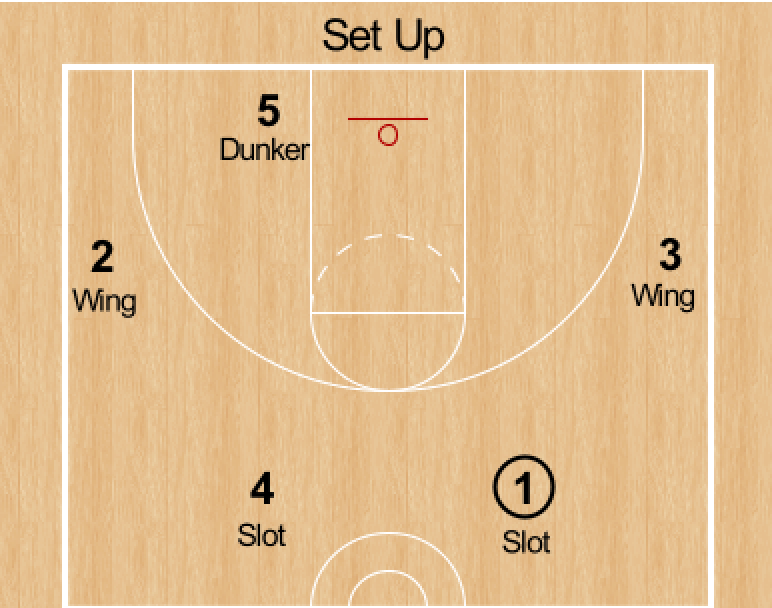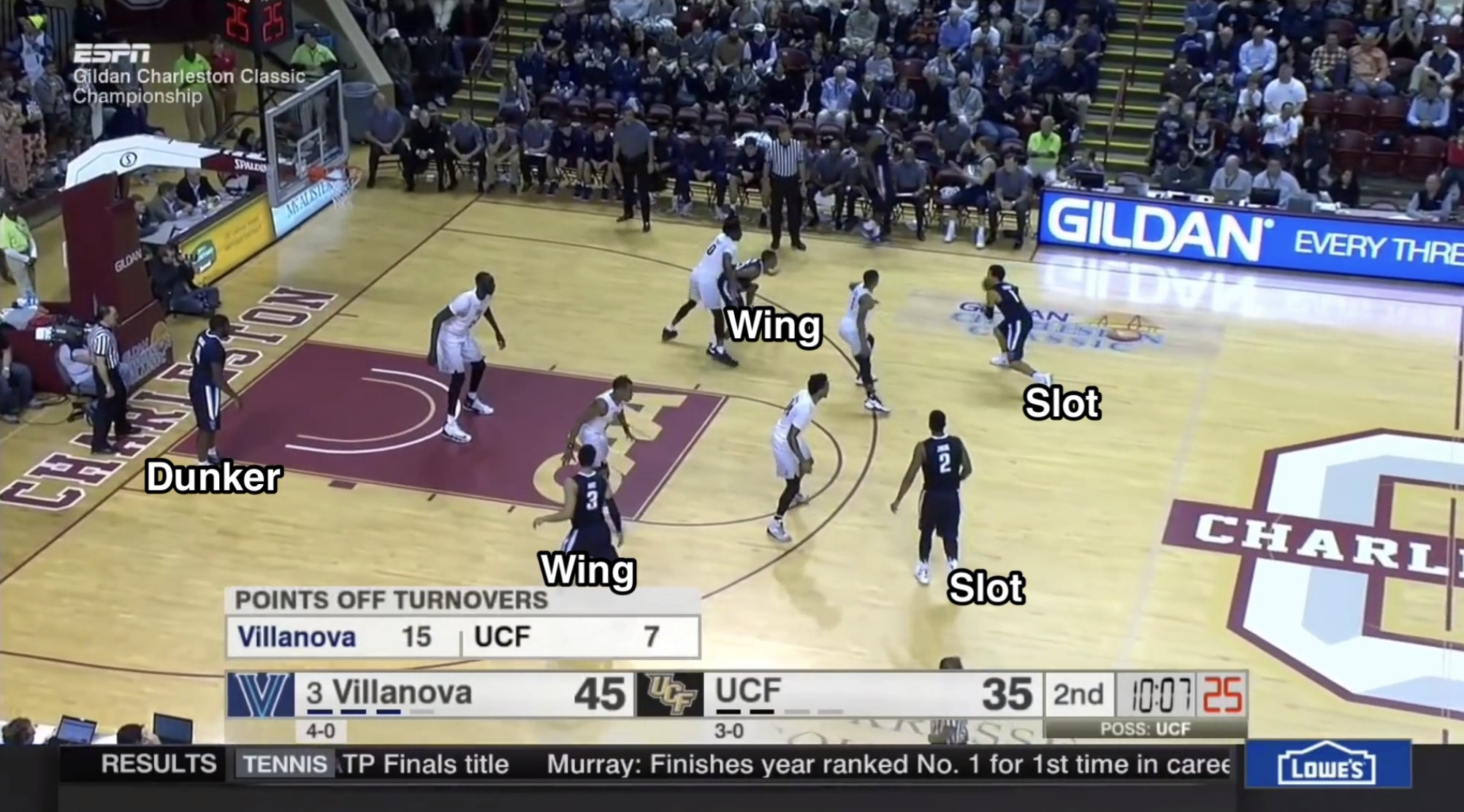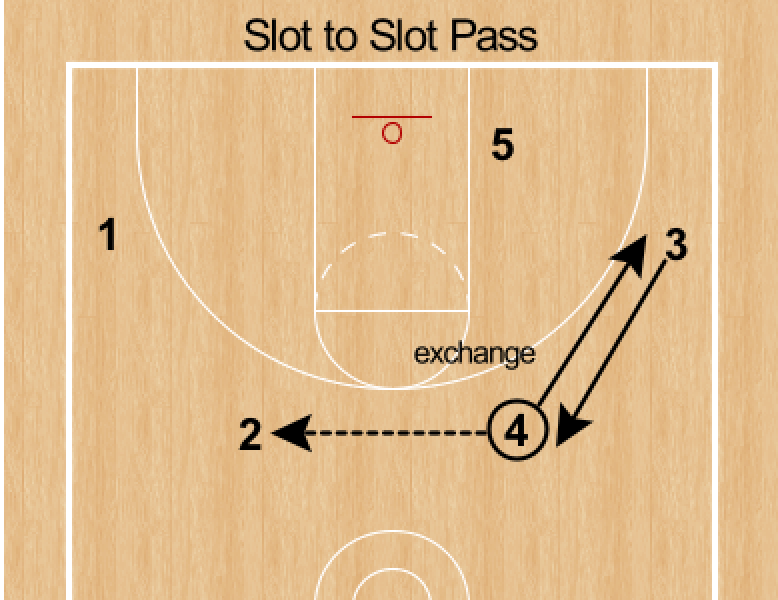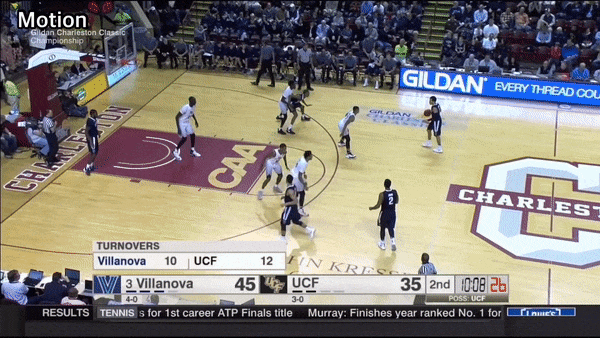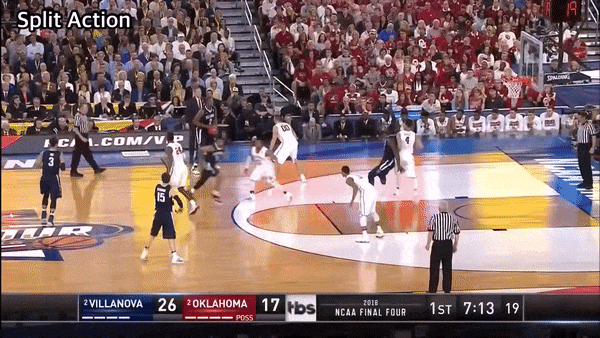Villanova’s 4 Out 1 in Motion Offense
Jay Wright’s Villanova Wildcats consistently have one of the most efficient and effective offenses in all of college basketball—as shown by their top ten ranking in offensive efficiency this past season. A main reason for this success is their 4 out 1 in motion offense, which is a staple of their efficient offense.
In this breakdown, we will take an in-depth look at Villanova’s spacing, the motion within their offense, and their go-to concepts they flow into in the half court.
In This Breakdown:
4 Out 1 in Spacing:
From their initial transition break, Villanova ends up in tradition 4-out spacing in the half court—2 players fill the slots, 2 players fill the wings and the 5-man fills the weak side dunker spot.
Having the 5-man initially occupy the weak side dunker spot creates space and driving lanes for the ball handler to attack downhill. If the ball is quickly swung to 3 on the wing, he can rip and drive baseline (a staple of Jay Wright’s teams) with the space 5 has created.
The perimeter players filling the slots are a little wider than elbow extended, and the players filling the wings are free throw line extended. The four positions around the perimeter can be filled by any player (1-4).
4 Out 1 in Motion:
If Villanova doesn’t have an advantage in transition, they typically start their half court possessions with a pass from the slot to the wing.
A slot-to-wing (1 to 3) pass triggers a “thru” cut from the slot through to the weak side wing. While it will rarely be open, the slot (1) should cut hard to potentially receive the give-and-go pass from the wing to score. The other perimeter players (2 & 4) rotate to fill the next spots.
If the ball is ever passed from the wing (3) back to the slot (4), Villanova looks to reverse the ball from slot-to-slot to get to the second side of the floor and shift the defense.
When the ball is reversed from slot-to-slot, the player in the slot who made the reversal pass (4) exchanges with the weak side wing (3).
This flow and pattern then continues—If the slot (2) passes to the wing (1), he thru cuts to the weak side wing and the remaining players (3 & 4) rotate to fill the next perimeter spots.
Early Post Entry:
With the action generally starting with a slot-to-wing pass, Villanova tries to achieve an early post entry most possessions.
On the pass to the wing, the 5 man rotates from the weak side dunker spot to the strong side block and ducks in for a potential post entry. If the wing cannot attack on the catch, their next option is to hit 5 for the early post up.
Jay Wright, like most coaches, coaches his big man to look to score on a post up before anything else. So if the wing is able to enter the ball to 5 on the block, 5 immediately looks to attack or get to his move looking to finish.
Not only are early post entries a great way to score quickly, they also put a tremendous amount of pressure on the rim early in the possession. This will often times collapse the perimeter defenders leading to open kick out threes.
Split Action:
If a post entry is made, Villanova likes to flow into Split Action to create a scoring opportunity or occupy the help or “choke” defenders so the post player has room to freely operate.
Villanova’s split action is initiated by the the post entry passer screening for the next closest player, immediately after entering the ball to the post.
This simple action locks in the two closest help defenders and prevents them from choking or collapsing on the post player, as they must guard the screening action. If the perimeter defenders fall asleep or decide to choke the post, this action can lead to easy back door cut or open three.
As shown in the video breakdown above, Villanova loves to slip their split action, especially if the defense overplays the screen. The screener slipping the away screen and diving to the rim creates a few easy buckets per game for Villanova.
If the defender guarding the post entry passer decides to choke or help down on the post player, he gives up an open catch and shoot three (assuming the post entry passer sets a solid screen).
To dive deeper into split action, check out the Golden State Warrior’s Split Action breakdown.
Slot Ball Screen:
If Villanova cannot attack in transition or get to an early post entry, they like to flow into their go-to action, a slot ball screen.
This ball screen action is typically triggered by a ball reversal. As the ball is being reversed from one side of the floor to the other, the 5-man sprints to set a ball screen for the ball handler in the opposite slot.
The ball handler’s (3) first option is to attack downhill off of the ball screen. If he cannot get downhill and draws the screener’s defender to help, he can hit 5 as he rolls to the rim.
The strong side wing (1) will also “shake” or lift to fill behind 3 as he attacks off the ball screen. 1 shaking up removes the possible “tag” or help defender on 5’s roll. If 3 cannot get downhill or hit 5 as he rolls to the rim, he can look to kick it back to 1 as he lifts for a shot, drive or post entry.
Since 4 reversed the ball slot-to-slot before the ball screen, 4 & 2 exchange (see Motion rules above) as the ball screen is taking place. This simple weak side exchange is extremely effective at removing “nail” or gap help defenders (who would typically help on 3’s attack). If the ball handler (3) has no other options off the ball screen, he can always kick it to the weak side for a shot or drive.
Playing Off the Catch:
The final, and perhaps biggest factor in Villanova’s offensive success is their ability to drive the basketball and get deep penetration to either finish at the rim or kick to open shooters along the perimeter.
Their ability to drive the basketball begins with their guards and wings ability to play off the catch. My biggest take away from watching Villanova’s perimeter players is the fact they catch every pass like they are going to shoot, meaning they are low on the catch and their eyes go towards the rim. This alone puts the idea of the shot in the defender’s mind, opening up the ability to attack off the catch. If they cannot shoot on the catch, they immediately look to drive before swinging the ball if no advantage is available.
Not only do Villanova’s guards do an excellent job of getting downhill, but they are always under control while doing so.
A big key to this is the fact that Jay Wright and his staff coach their players to always play off two feet in traffic, whether it be with a jump stop or stride stop. Playing off two feet allows Villanova’s guards to attack under control, pivot out of trouble, kick to shooters, etc. all while still being able to finish at the rim if they have space.

